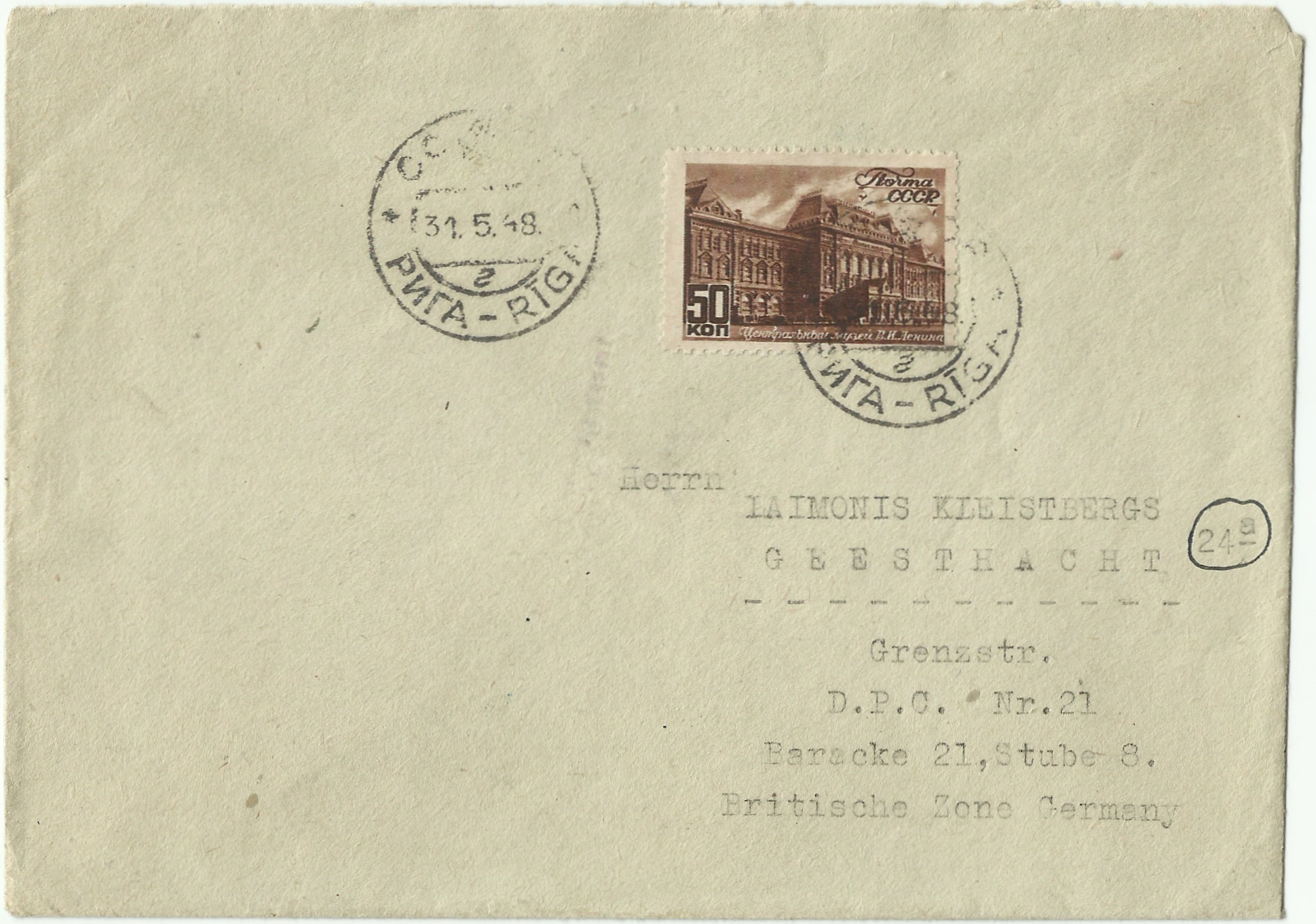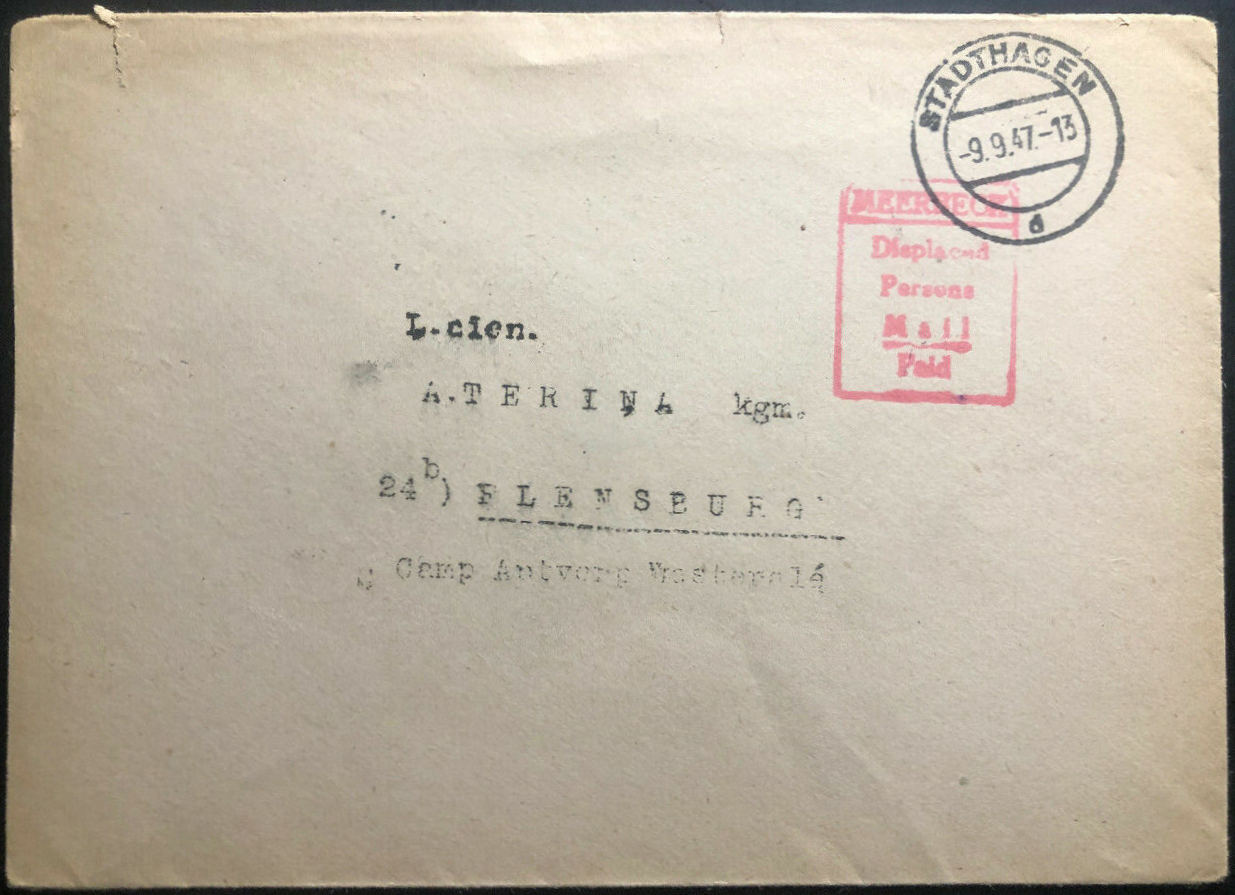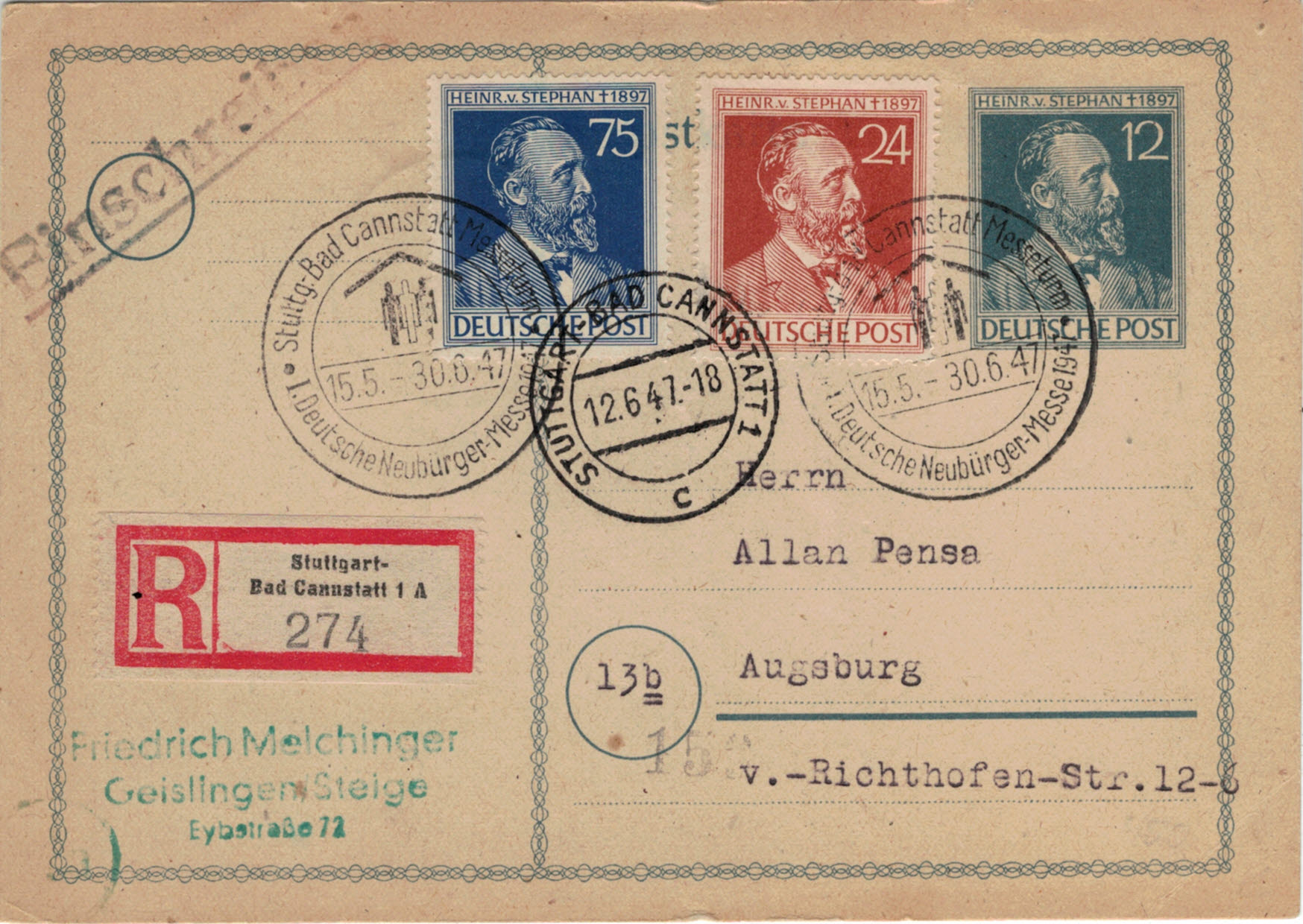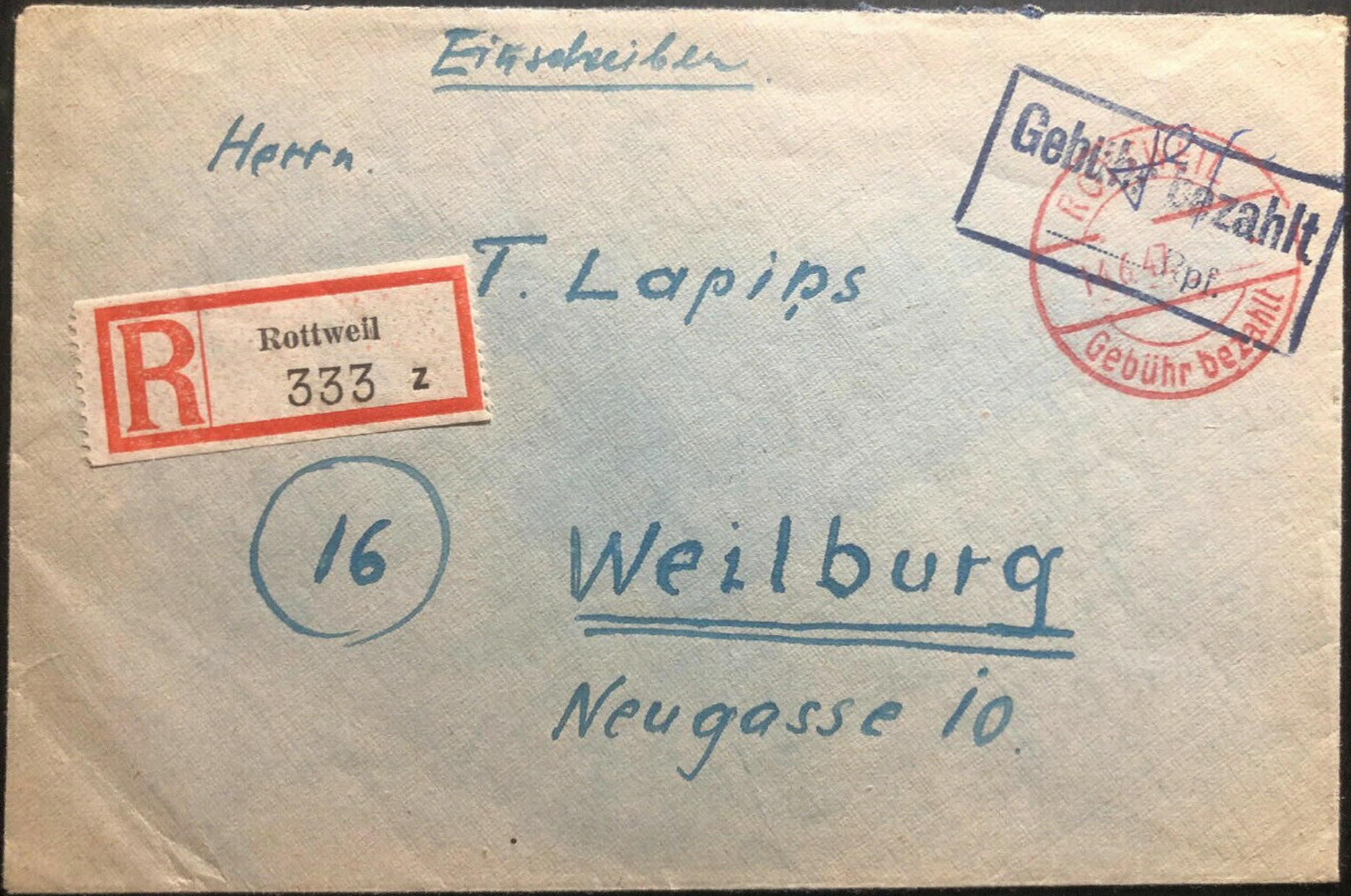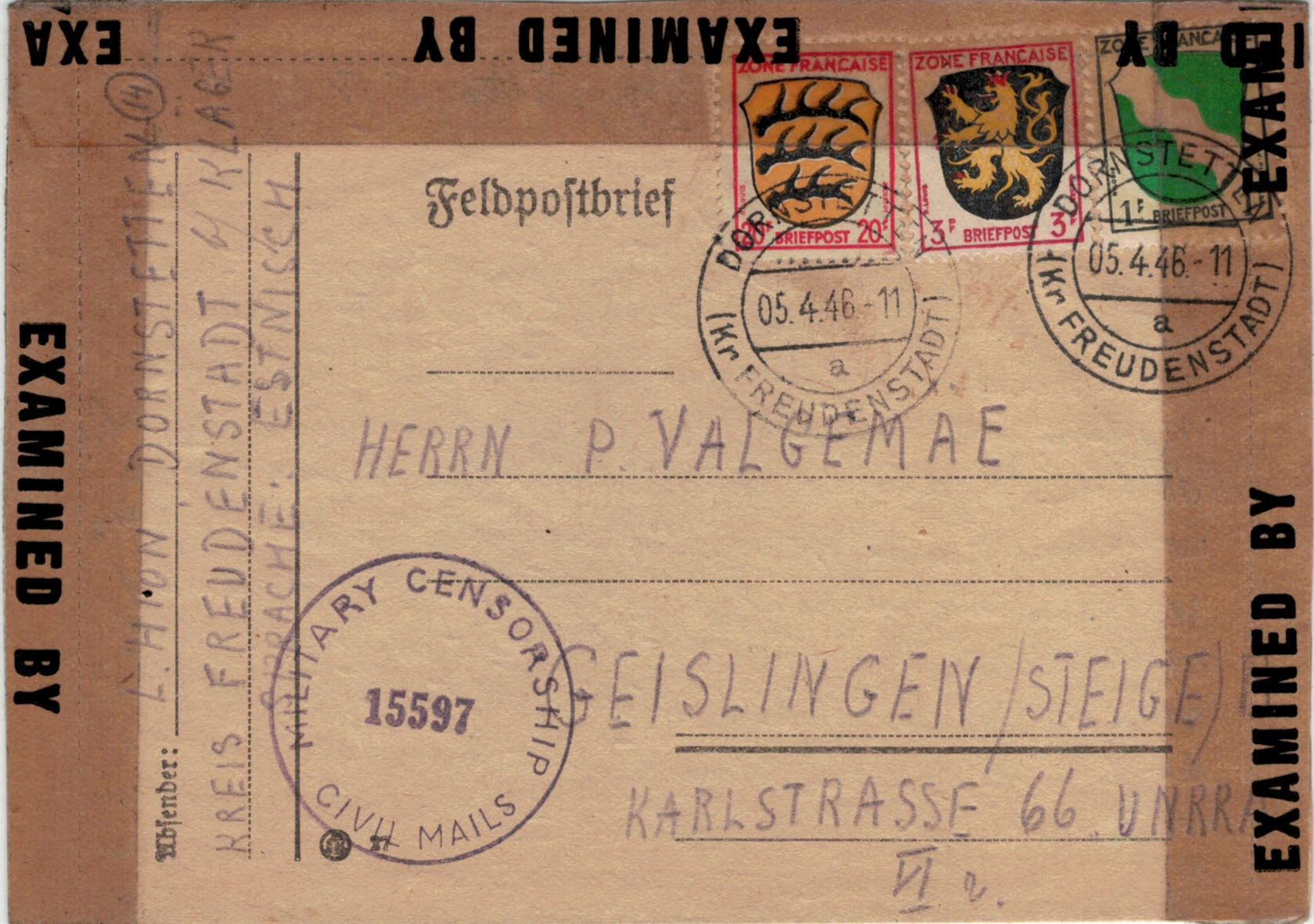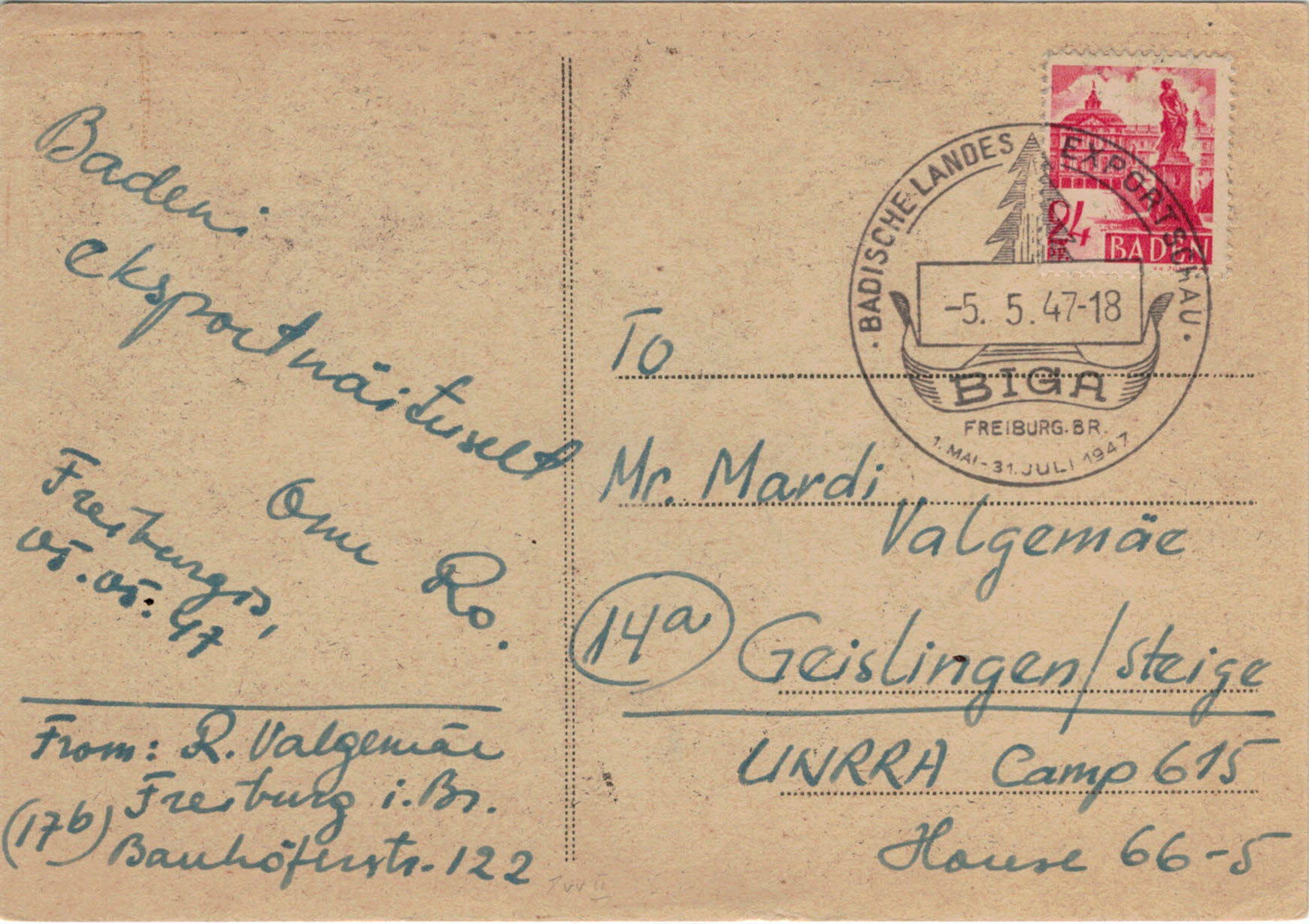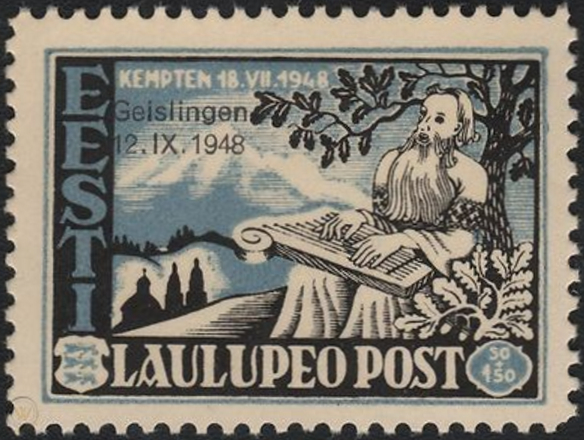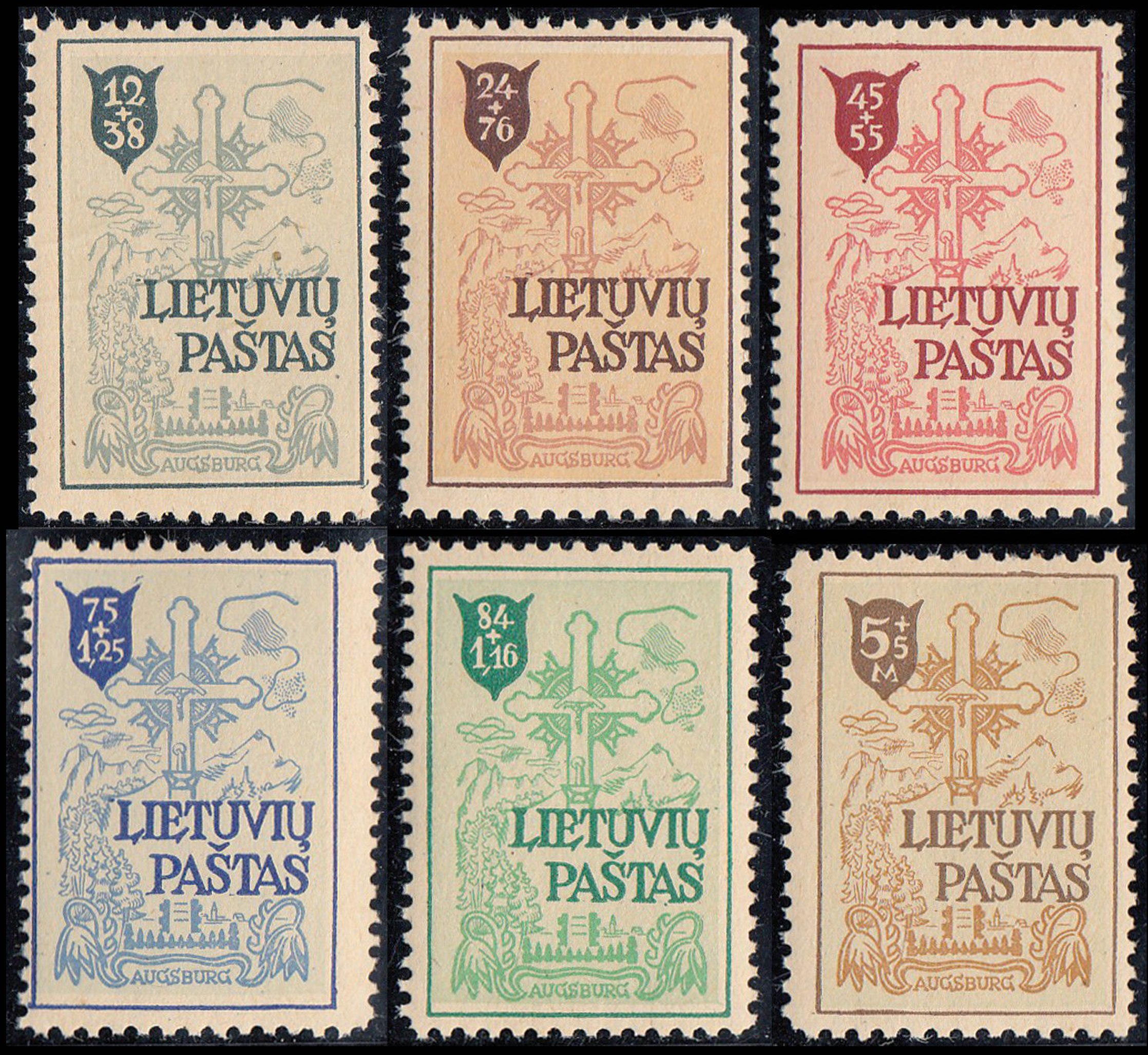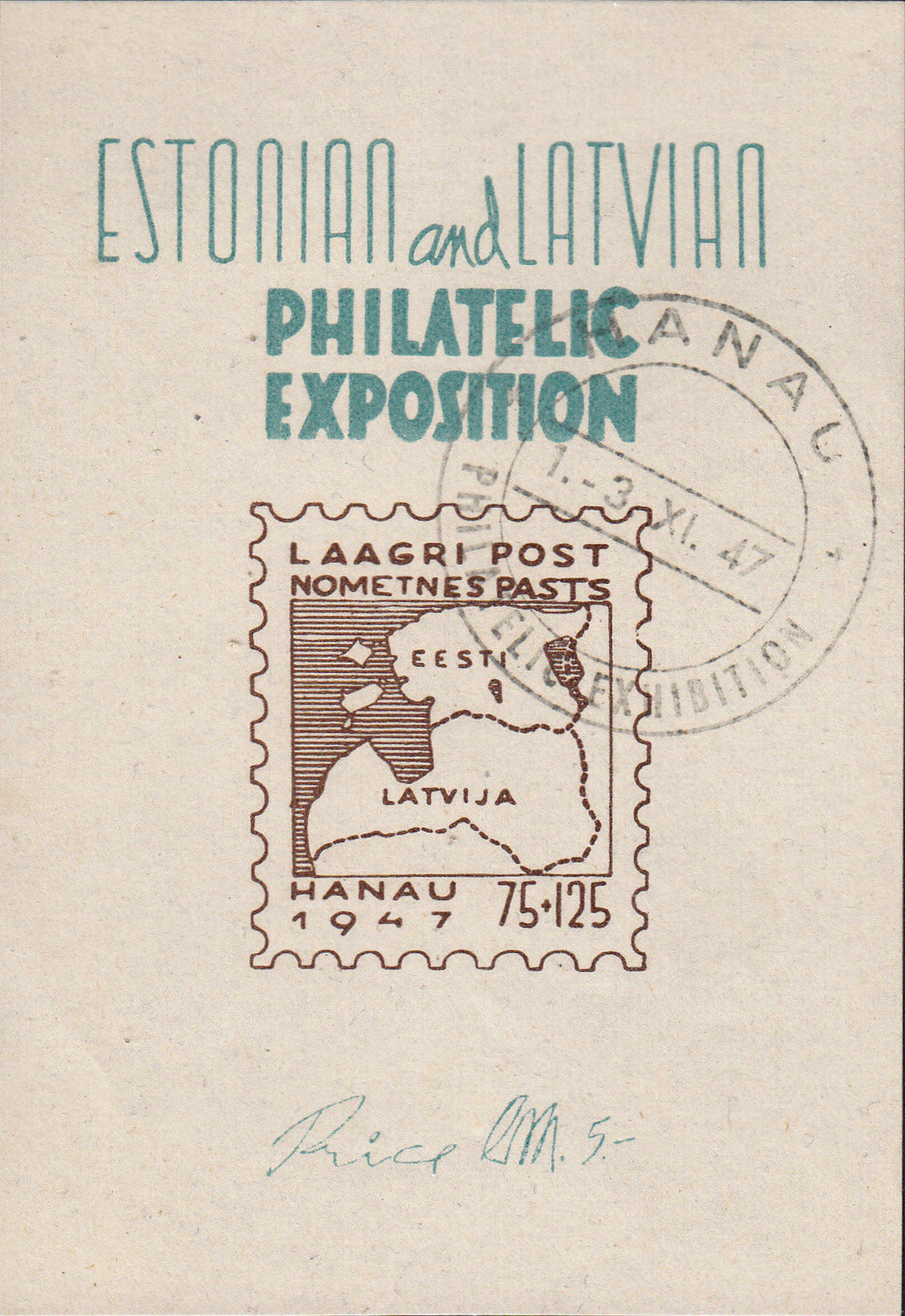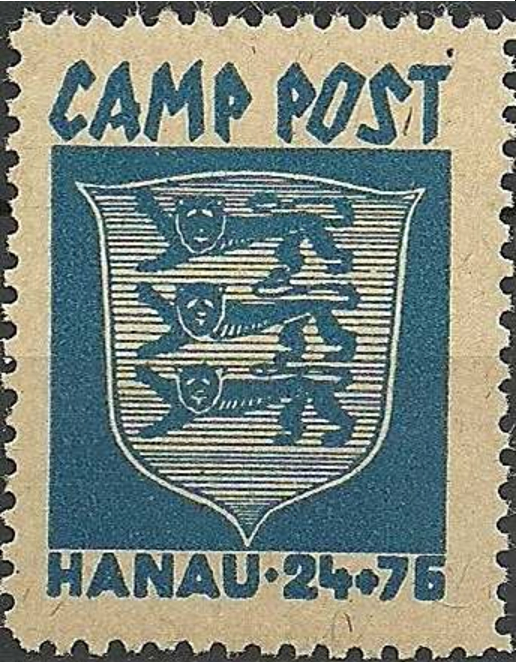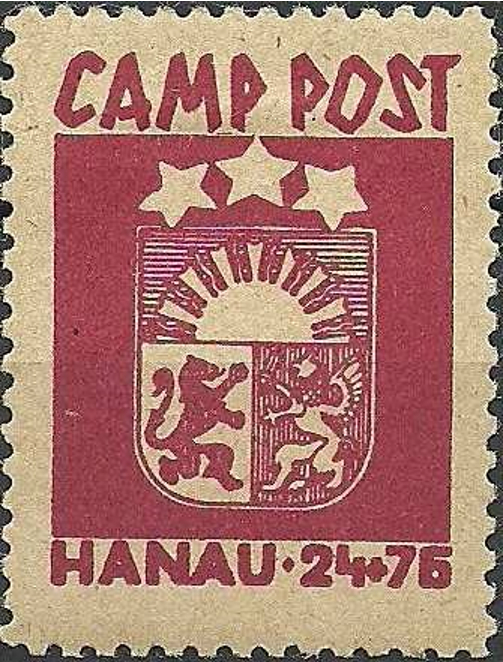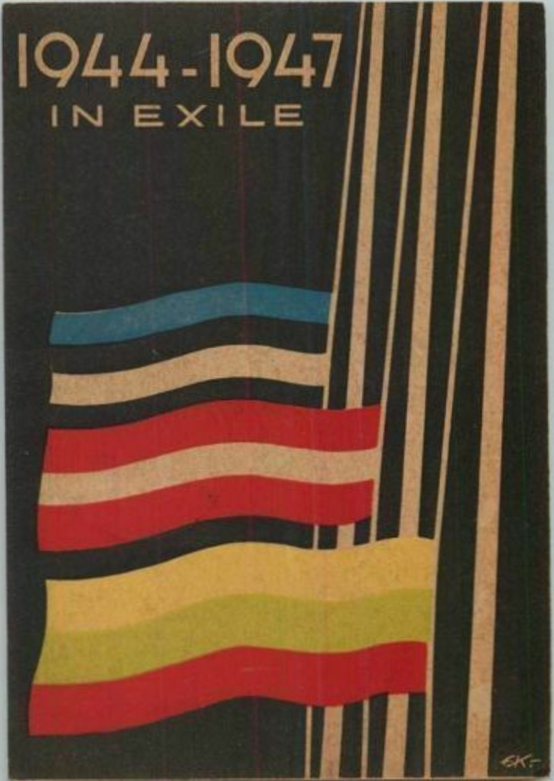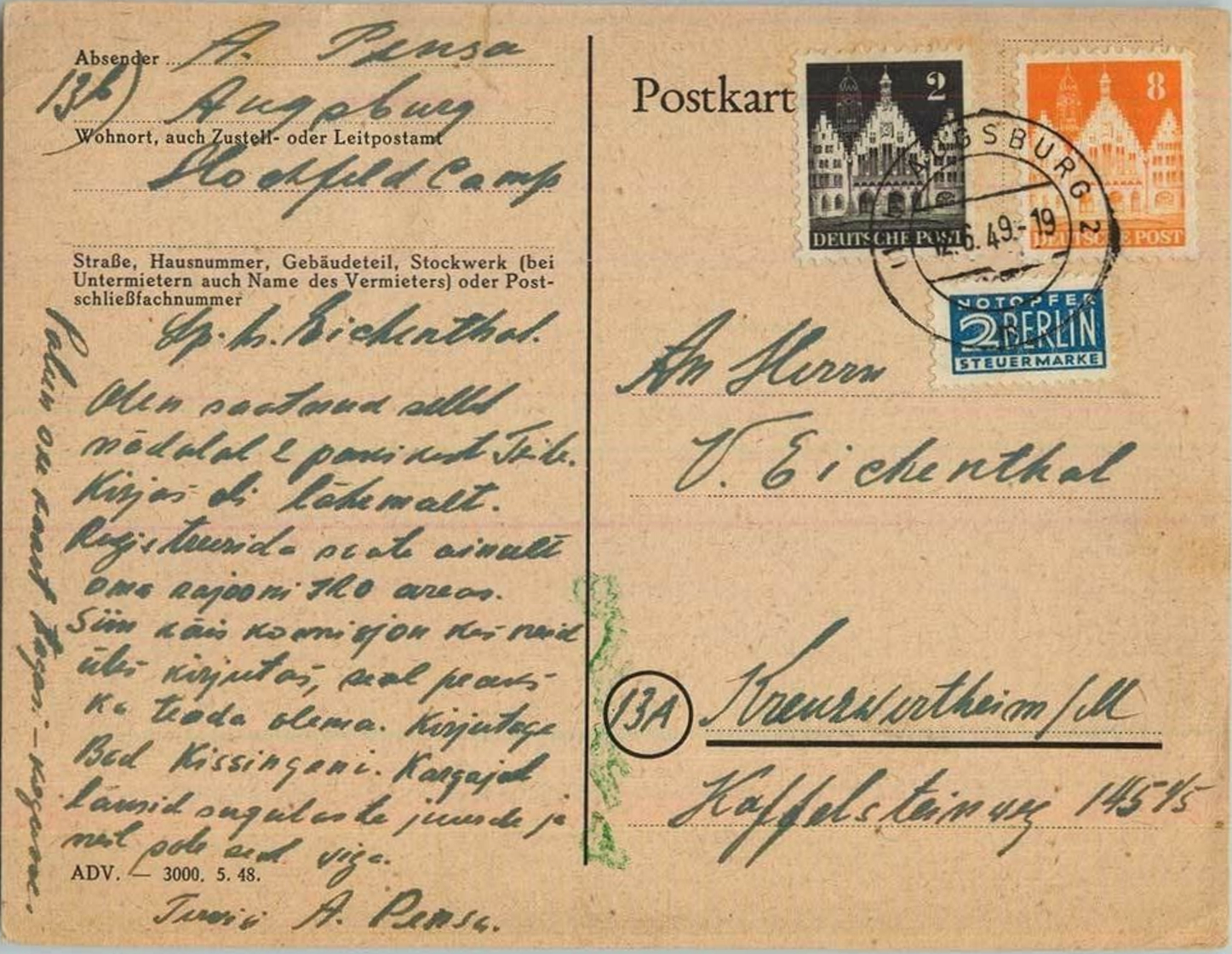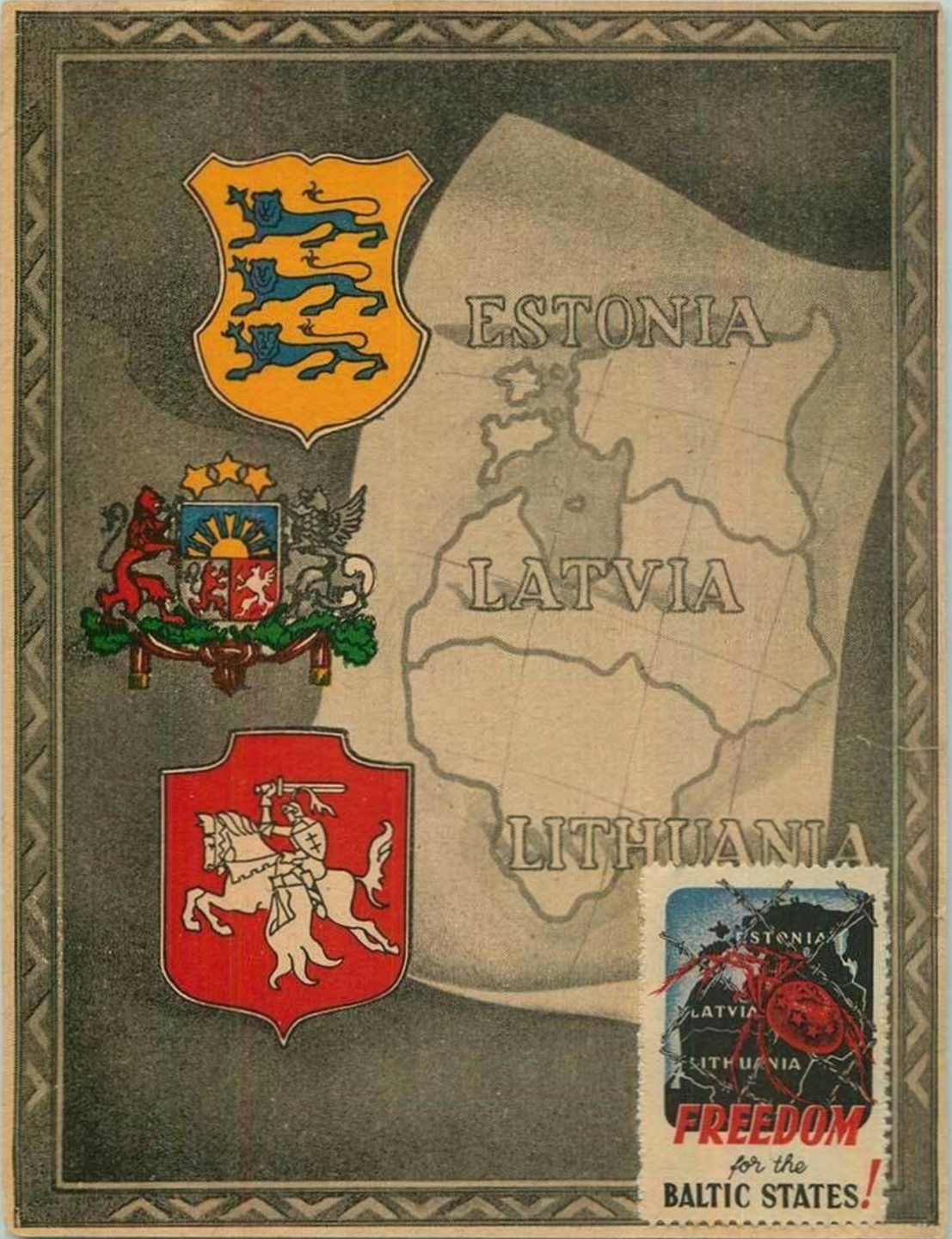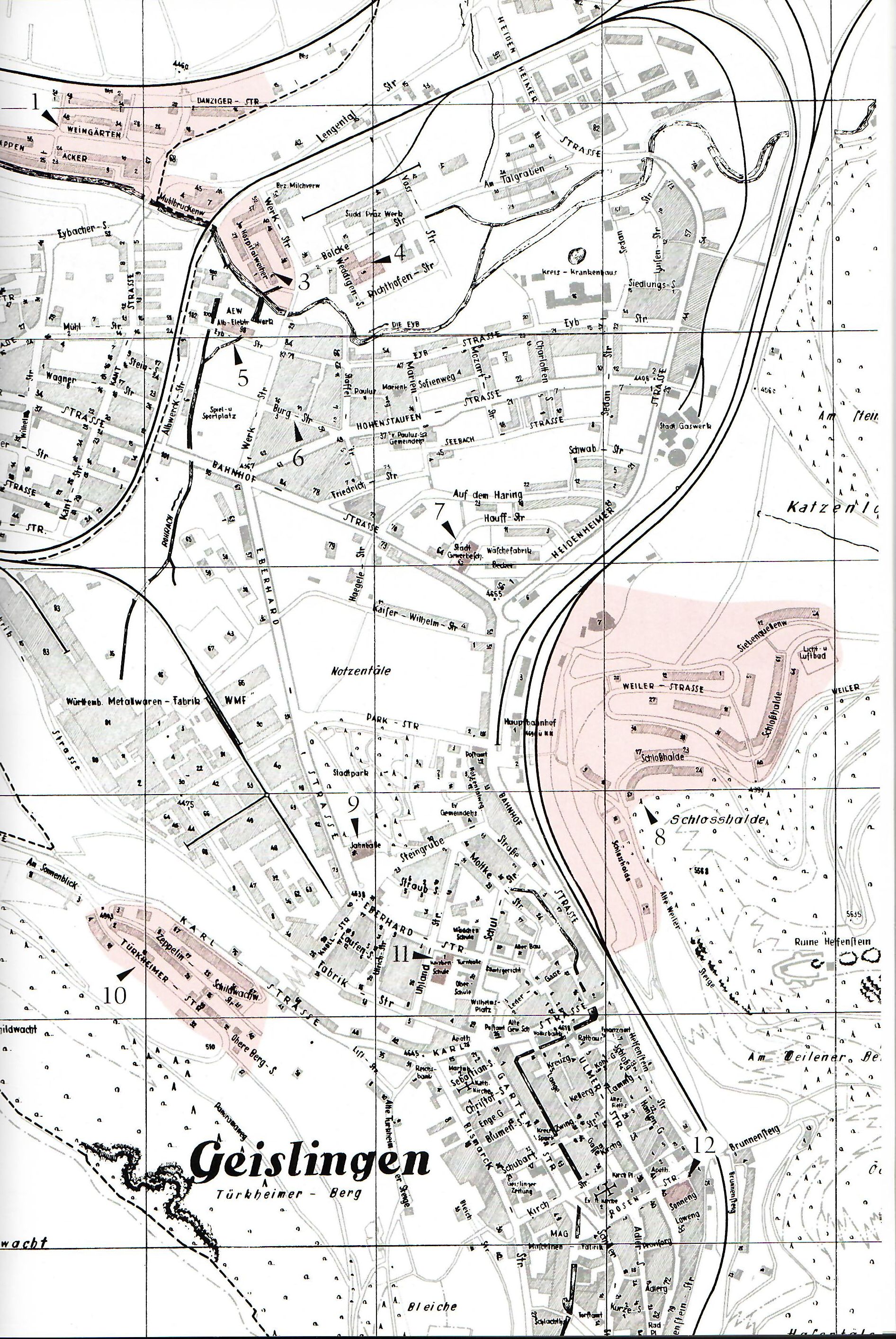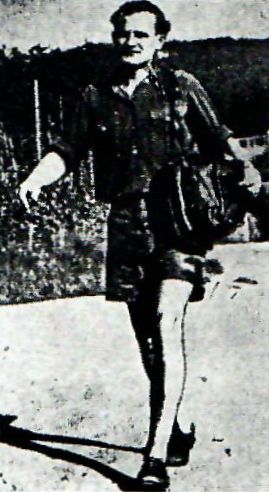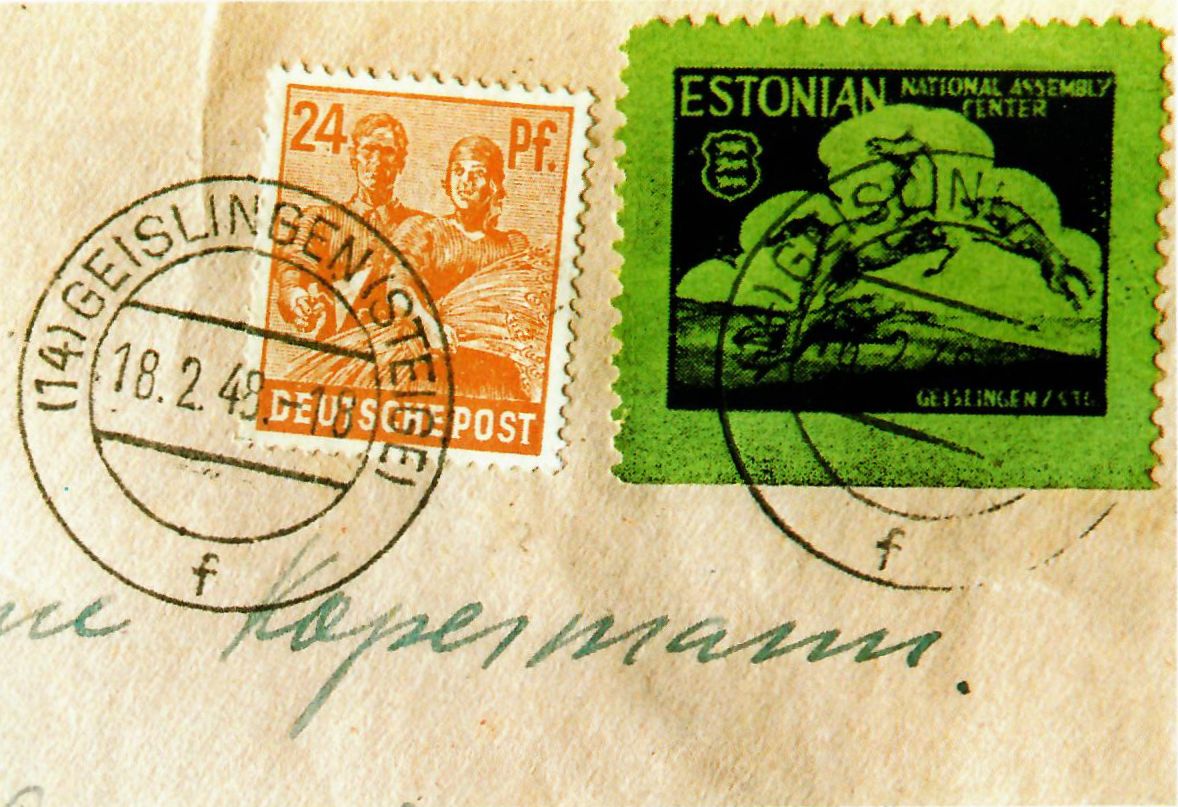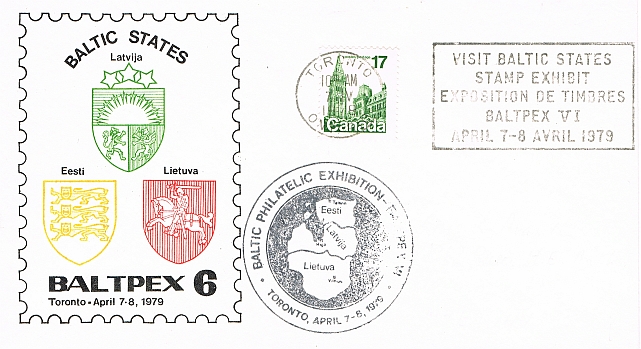Estonia
-
Royal Swedish Post
-
Imperial Russian Post
-
German Occupation / Ob. Ost
-
Independent Republic of Estonia
-
Soviet occupation
-
German occupation / Ostland
-
Camp mail / Estonians in exile
DP Camps
With the advance of the Soviet Army to the west, many Estonians decided to flee in 1944. Simultaneously with the evacuation of the General Commissariat Ostland, the majority of them initially moved to the German Reich, where they attempted to be interned under the protection of the Western Allies after its surrender on 8 May 1945. The same applied to Latvians and Lithuanians.
Already before the Normandy landings, the Allies were aware that they would find many people from all over the world in Germany and the areas it occupied. (11 million people were expected). The Supreme Headquarters, Allied Expeditionary Forces (SHAEF) decided to gather them in camps and to repatriate them to their home countries as soon as possible. SHAEF also involved other organisations in the implementation of these measures, in particular the United Nations Relief and Rehabilitation Administration (UNRRA), a division of the United Nations founded on November 9, 1943, whose first teams arrived in occupied Germany in April 1945. In May 1946, 279 teams looked after a total of 765,000 people in collective camps (see chart). On June 30, 1947 UNRRA closed down its activities in Germany; from then on, the International Refugee Organization (IRO) took care of the homeless foreigners.
In Germany, the Balts were quartered in collective camps for "Displaced Persons" (DP camps). DPs were, in the strict sense, people who had been forced labourers in Germany or had been forcibly taken into the Reich territory by the Germans. In a broader sense, however, they also included people who had voluntarily worked for the Germans in Reich territory, had served in the German Wehrmacht or had fled the Russians from the Baltic states.
In total there were hundreds of DP camps, see for example this list or the adjacent graphic.
However, the Balts who remained in Germany understandably had little interest in repatriation as long as the Soviet Union occupied the Baltic states.
After years of living in the DP camps, the refugees realised that they would not be returning to their ancestral homeland, at least not in the foreseeable future. Since Germany had been completely devastated by the war, the German population had hardly any housing or work and the German economy was destroyed, it was not possible for the DPs to remain in Germany.
From September 1946 emigration to another European country or overseas was advertised; this was intensified in 1947. After a health examination (single, able-bodied male DPs had the best chances) and a check of the political past, emigration could take place, mostly via the emigration camp in Ludwigsburg.
Estonians emigrated mainly to Sweden, the United States of America, Canada and Australia. Smaller groups remained in Germany or Denmark, etc.
After the founding of Israel in 1948, Jewish DPs could emigrate there, and also the USA temporarily liberalised their immigration conditions. In 1949, emigration reached its peak when as many as 260,000 DPs could be placed in a new homeland.
At the end of 1945, there were about 1.7 million DPs in the three western occupation zones. On 1.1.1947, 270,000 deportees were still living in the British Occupation Zone (BOZ). Most of them were Poles, Latvians, Ukrainians and Estonians. Almost all of them were in camps. At the end of 1947 there were still 108 camps. By 01.03.1949, the number of deportees in BOZ camps had fallen to 142,000. There were still 67 camps at the end of 1949.
On 1 July 1950, the German Länder took over the care of the 85,000 deportees who had remained in the Federal Republic and had no prospect of settling abroad. For a further 113,000 deportees who were still hoping to emigrate, the IRO cared for them initially until 31 March 1951 and finally until the end of 1951, when it was dissolved.
The Federal Act on the Legal Status of Foreigners who had been Displaced from their Homeland of 25.4.1951 largely equated those with German refugees. Now the deportees were called "homeless foreigners".
(Sources:
– Website about DP camps, on the internet at URL: www.dpcamps.org/dpcampseurope.html
– Wikipedia on DP camps, on the internet at URL: https://en.wikipedia.org/wiki/Displaced_persons_camps_in_post-World_War_II_Europe
– Virtual exhibition on camps in Germany for refugees from the Baltic states, on the internet at URL: www.archiv.org.lv/baltic_dp_germany
– Directory of German DP camps in the – UNESCO-sponsored – Arolsen Archive, on the Internet at URL: dpcampinventory.its-arolsen.org
– Directory of DP camps worldwide, on the internet at URL: www.dpcamps.org
Mail between DP camps, other domestic mail and foreign mail
Until the 1950s, UNRRA, the IRO and many foreign aid organisations that looked after the displaced persons enjoyed exemption from fees for their shipments within Germany.
According to Art. 71 I GA III of the Geneva Convention, all belligerents are obliged to transport the mail of prisoners of war free of charge. (except airmail and other surcharges). In addition to the private mail of the prisoners of war, this included mail to the outside world as well as mail within the camps. The Allies were therefore obliged, after the occupation of Germany, to allow prisoners of war in DP camps to send mail free of charge (postage-free mail) from the DP camps. This also applied to DPs who were not prisoners of war in the strict sense. In some camps a separate postal service was set up, which was responsible for transporting (collecting, distributing) the outgoing (or incoming) mail and generally charged a fee for this.
Sometimes this "postal organisation within the camp" also issued their own stamps, which then had to be used to postage items to be transported within the camp. More about this "camp mail" in the narrower sense below.
Regarding the mail of displaced persons out of the camps, there were differences between the occupation zones:
* * *
In the British Occupation Zone, the DPs enjoyed postage-free postage for letters from DP camp to DP camp, within the British Occupation Zone as well as abroad, according to decrees of the Reich Postal Directorates of Braunschweig, Düsseldorf, Hamburg and Hannover and corresponding British orders from 20.10.1945 (NB.: the start of civilian postal traffic from Germany to foreign countries did not take place until 1.4.1946!)
The letters were sent via the British Field Post Office (FPO) until 4.5.1947. Camouflage addresses without location information were to be used for this purpose; these camouflage addresses contained the numbers of the Assembly Centres (AC) and the Displaced Persons Assembly Centre Staff (DPACS, DPAC Administration), from July 1947 also called DPACCS (Displaced Persons Assembly Centre Commanding Staff).
From 5.5.1947, letters from DPs were no longer transported abroad by the British field post. Therefore, from this date onwards, camouflage addresses (such as the AC number, the censorship office "800 Control Unit" or also the routing mark "BAOR via Gt. Britain", BAOR = British Army of the Rhine in Germany) were no longer used, but the open camp address with the Assembly Centre number, town, street and house number.
From now until 19.4.1949 the Deutsche Post had to bear the charges, then the postage-free carriage within Germany ended. Single items sent abroad were postage-free until 31.8.1949.
The DPs had to use envelopes for further postage-free transport, on some of which the postmarks of their camps were stamped, in any case also either a postmark at the top right with "Displaced Persons Mail Paid", which were designed in various shapes (mostly rectangular) or sometimes also with adhesive labels (in Meerbeck) or typewritten on adhesive labels (in Dortmund). In Meerbeck and Leese, the place name also appears in the postmark.
From February 1949, the British military government introduced the two-line postmark "Displaced Persons Mail Paid". and this was also published by the Head Office of the Post Office in Frankfurt on 4.3.1949 (for ordinary items).
However, the majority of domestic letters from DPs were franked with stamps for lack of knowledge on the part of the camp commanders about the exemption from postage for domestic mail in the British zone, i.e. the exemption from postage was actually used very little. That is why there is hardly any circulated domestic consumer mail.
* * *
In the American and French zones of occupation as well as in Berlin there were no comparable regulations; here, domestic and foreign mail always had to be franked.
* * *
There were no DP camps or comparable facilities in the Soviet occupation zone.
* * *
Sources:
– Heinz K. Selig: Free Franking for Displaced Persons in the British Zone in Germany, on the internet at URL: http://www.schaumburgerpostgeschichte.de/Dokumente/Meerbeck_St_Luois_DP_Post.pdf (PDF document format A4 portrait as reading text) and www.consilium-philatelicum.de/fileadmin/bilder/digitale_vortraege/displaced.pdf (PDF document of a PowerPoint presentation)– Compilation of DP camp information under philatelic aspects in the web of the late Manfred Heber, on the internet under URL: fuchs-online.com/Lagerpost.Info
Literature:
– Wolfgang Strobel: Post der befreiten Zwangsarbeiter (Mail from the liberated forced labourers). Displaced Persons Mail Paid in Germany 1945–1949. 2001 (only available antiquarian).
– J. Müller: Müller Briefmarkenkatalog Deutschland Spezial, 7th ed. 1957, with stock postage stamps (only available antiquarian).
– Villem Eichenthal: EESTI – Illustrated Special Catalogue Estonia, published by the Philatelic Specialists Society of Canada, 1962 (only available antiquarian).
– Friedrich Wilhelm: Lagerpost / Displaced Persons / DP Camp, Volumes I and II, available at: dp-camp.jimdofree.com
Issue of camp post stamps
Until the refugee administrations of the German Länder took over on 1 November 1951, DP camps constituted "extraterritorial" territory. The issuing of camp stamps by e.g. scouts or camp committees therefore did not require a German postal permit, but only a permit from the Allies (UNRRA or IRO). Inscriptions are always in English.
Known is the issue of camp post stamps at the following places with Estonian, Latvian and/or Lithuanian inhabitants:

Altenstadt/Schongau, May 1946, advertising stamp for the Baltic DP exhibition, camp post dated 24.5.–16.6.1946
Hanau, 1.11.1947, advertising issue with surcharge on the occasion of the Estonian-Lithuanian Stamp Exhibition November 1-3, 1947 (souvenir sheet and single stamps).

Detmold 1946, general issue with lily coat of arms (Boy Scout symbol) and Lithuanian marksman's cross, 20+80 Pfg. also with overprint "Augsburg / 28.4.46" in red as commemorative stamp for the meeting of the exiled Boy Scouts from Estonia, Latvia and Lithuania.
The camp postage stamps had no franking power outside the camps. However, they were often affixed to letters to Germany and abroad as commemorative vignettes next to valid stamps and sometimes (contrary to regulations) also postmarked.
The BALTIA Stamp Association
Representatives of the three Baltic states formed the BALTIA stamp association (1946–1950), which, among other things, organised philatelic exhibitions and issued commemorative stamps. It also published a stamp catalogue on the stamps of the republics of Estonia, Latvia and Lithuania with Memel 1918–1941 including the Soviet and German occupation (see Literature references.
The board of the association, founded on 17 July 1946 in Augsburg, included Aleksander Vahter (Estonia, chairman), N.N. (Latvia) and Juozas Liubinskas sen. (Lithuania) (both assessors) as well as August E. Pensa (Estonia, head of organisation). In 1948 the association had about 300 members. On the left a letter from the 1947 annual meeting, on the right an accompanying postcard to a parcel dispatch from A.E. Pensa to Villem Eichenthal, i.e. from one well-known Estonian philatelist to another.
Estonian Camp Post Stamps
In Baden-Württemberg, for example, the Estonians were quartered in Geislingen/Steige in settlements to be cleared of Germans, in Bavaria in camps in Altenstadt/Schongau, Augsburg/Hochfeld, Kempten and Nürnberg-Langwasser, Dettendorf, Ingolstadt, Neuburg, Ulm or Wielandshag/Freilassing, in Hesse in Wiesbaden and Hanau, in Lower Saxony in Leese and Oldenburg, in Schleswig-Holstein in Lübeck or Schwarzenbek, in Baden-Württemberg in Müllheim and Freiburg, in Rhineland-Palatinate in Kaiserslautern, to name but a few. In total, Estonians were accommodated in over 150 camps.
The Estonian camp post in Geislingen/Steige
Representative of the Estonian camp mail in Germany, the following is taken from the book "Stille, Bernhard 1994: Vom Baltikum ins Schwabenland. Estenlager und Ausquartiertenschicksal in Geislingen 1945–1950. Veröffentlichungen des Stadtarchivs Geislingen/Steige Band II. Weissenhorn: Konrad-Verlag." (Text and illustrations with kind permission of the publisher):
Since on the one hand the three districts of Schloßhalde, Wilhelmshöhe and Rappenäcker were far apart, on the other hand, Geislingen's postmen were forbidden to enter the Esten camp, UNRRA camp administration set up its own camp post office, which cooperated with the German post office of the town of Geislingen. All the so-called Estonian mail was brought by mail cart from the German post office to the Estonian post office, where it was collected personally by the camp residents, later delivered to the recipients by postmen. The Estonians always had to collect parcels personally throughout the camp.
Initially, when postal traffic with foreign countries was not yet permitted, a few postal workers employed by UNRRA were sufficient to handle incoming and outgoing mail. However, when in the years 1946/47, international postal traffic was liberalised and the parcels sent from foreign Estonians in the USA and Sweden arrived in larger quantities, the Estonian camp administration had to recruit more postal workers. However, these were no longer paid by UNRRA. Therefore, the Estonian Post Office had to had to find new sources of income. Thus it came about that the Estonian camp administration, with the approval of UNRRA, decided to issue its own camp stamps.
The stamps were designed by the Estonian Aleksander Daniel and appeared on November 4, 1947. They showed a horse being chased by two wolves, a symbolic representation of the Estonians persecuted by the Russians. The designation of the stamps: ESTONIAN National Assembly Center Geislingen/Stg., next to it the Estonian national coat of arms, the three leopards in the breast shield.
The stamps were printed without value in the colours green, pink and red. The green ones were sold for 10 pfennigs and were used for franking postcards, letters and printed matter for the post office within the camp. The pink stamps were sold at 25 pfennigs and were used to collect penalty postage. This was the daily fee for parcels that had been left lying around. Since there was no room to store the parcels arriving in large quantities, and no vehicle to deliver them, the recipients had to collect the parcels as quickly as possible. This was also the purpose of the red stamps, which were sold to cover a four-day storage fee and cost 1 mark. Their number of copies was very small.
To cancel the stamps, the Geislingen post office had borrowed a round stamp with a three-line date that could be adjusted, without indicating the place.
The complete set of three values is very rare because of the small edition. Even rarer are real postal stationeries, which could only be franked with the green stamps. Most envelopes, however, were carelessly thrown away by the vast majority of camp residents at the time, as they were worthless to many.
Moreover, the Estonian post stamps were only valid within the camp; * for mail to other German places or abroad, one had to affix the stamps of the American occupation zone / Deutsche Post. It was only completely rare for an Estonian stamp to be stamped next to a German stamp by the Geislingen postal clerk because the sender mistakenly thought that he had to use both the Estonian and the German stamps.
When the Estonian DP camp was dissolved on June 24, 1950, the Estonian Post Office also terminated. The remaining stocks of green stamps were distributed among the postal officials of the time and other interested parties; the pink and red stamps were completely used up. The postmark was returned to the German post office. Thus ended a peculiar chapter of the Geislingen postal system.
* * *
* Harald Vogt reports in his article "Estonia – 1944 – 1991" in "Eesti Post No. 33/2001" , that the camp postage stamps (at least in other camps) were also used as surcharge postage for incoming express letters and telegrams and as surcharge postage for outgoing money transfers.
Sources:
– Ernits, Erich 1948: 3 aastat Geislingenis (3 years in Geislingen). Göppingen. Printed by: Gebr. Bott. Also on the Internet at URL: www.digar.ee/viewer/et/nlib-digar:269143/249071/page/1.
– Stille, Bernhard 1994: From the Baltic to Swabia. Camps for Estonians and fate of those quartered out in Geislingen in 1945–1950. Publications of the town archive Geislingen/Steige Volume II. Weißenhorn: Konrad-Verlag.Further information:
– Kromm, Max & Vogt, Harald 2000: They remained Estonians – also abroad connected to the home country after escape and exile from 1944/45. Philatelic References. Heide: Paul von Sengbusch Verlag.
– Goeze, Dorothee M. 2011, The Everyday Life of Estonian Displaced Persons. The Hintzer Collection at the Herder Institute Marburg. In: Õpetatud Eesti Seltsi Aastaraamat / Annales Litterarum Societatis Esthonicae 2010 (p. 173-201). Tartu. Also on the internet at URL: www.ut.ee/OES/wp-content/uploads/Goeze4.pdf
– Tõnismäe, Signe 2015: Estonian displaced persons in post-war Germany. Master's thesis. University of Tartu, EuroCollege, European Studies, on the Internet at URL: mobile.dspace.ut.ee/bitstream/handle/10062/46905/Tonismae_Signe%20_2015.pdf
Estonians in exile
In exile, events such as singers' festivals and scouts' meetings were held and organisations were often established to maintain the culture of the homeland. Philatelic associations were founded, which of course could not issue postage stamps, but did arrange for vignettes, decorative covers, by-postmarks or even postmarks of the official postal administrations with motifs from Estonian culture. They also produced publications, organised exhibitions, celebrated anniversaries and more.
Particularly noteworthy are:
EFÜR – Eesti Filatelistide Ühing Rootsis (Estonian Philatelic Association in Sweden)
EPS–NY – Estonian Philatelic Society in New York
Eestin Keräilijät – Estonian Collectors' Society in Finland
and groupings in Canada and Australia.
Cover for the 75th anniversary of the Estonian national flag 'Eesti Lipp', which first flew in Otepää on June 4, 1884 in the colours blue (like the sky) - black (like the peasants' boots) - white (like the snow).
The sender and producer of the vignette is the Estonian Philatelic Society in New York.

Cover from the Estonian Philatelic Society in the United States, who regularly met in the Estonian House in New York, to the Estonian Georg Kuik, born in Petrograd and working as a pharmacist in Munich..

Letter from August E. Pensa, member (and 1953–1966 chairman) of the Estonian Philatelic Society in the United States and editor of the "Marginalia of the Estonian Philatelic Society" (1959-1960) to the Estonian historian Arnold H. Joonson at the (now defunct) linguistic publishing house "Võitleja" (= Fighter) in Heidelberg.
Receipt for the 100th anniversary of one of the first Estonian Singing festivals in 1863 in the village of Anseküla on the Sõrve peninsula (Saaremaa Island).The Estonian Philatelic Society in New York is also the producer of the overprint.
Receipt for the 10th anniversary of the Stockholm-based Estonian Philatelic Society in Sweden "EFÜR", which celebrated this anniversary with a stamp exhibition week ( November 22 – 29, 1964).
Letter from the collector Harry A. Malm, who emigrated from Estonia to Sweden, from the stamp exhibition in Stockholm to Paul-Sigfrid Lanno from Valga, who emigrated to Australia via Italy in 1949.
Fair cover of the "Baltpex 6". Baltpex was a stamp exhibition covering the entire subject of philately of Estonia, Latvia and Lithuania and was held at changing locations, but often in Toronto. -
Independent Republic of Estonia (restored)
-
Private Mail in Estonia




